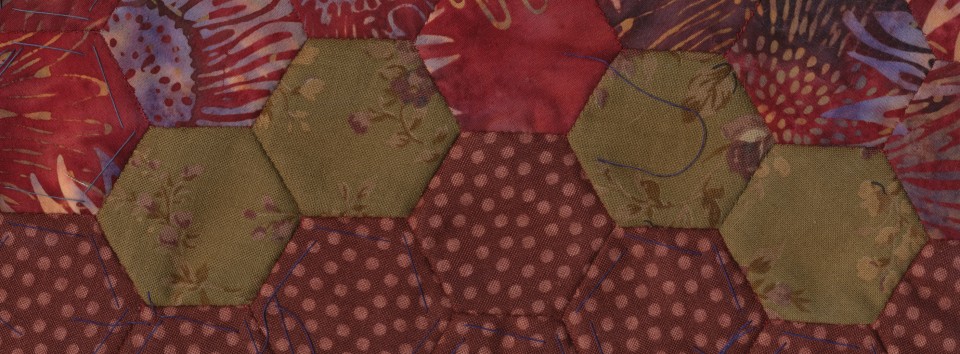Second Act Saturday is a recurring feature through which I share projects created during my Second Act In Fibers, but about which I have not previously blogged. It’s a way of getting my full body of work up on the web eventually.
Today’s post is about a pillowcase that my husband requested that I make for him to cover a very old, large, and dirty pillow which he loves. The pillow was originally covered with corduroy, but could not be laundered. At one point I covered the pillow with some flannel sheeting because it had gotten so dirty, but I actually stitched the sheeting onto the pillow, so it still couldn’t be laundered.
When I started to create objects out of hexagons my husband saw an opportunity to request a simple utilitarian cover for his beloved pillow. I saw an opportunity to use scraps, or crumbs, left over from the creation of basted hexagons. I also saw an opportunity to find out if the maroon fabric I had purchased was going to run if I didn’t prewash it. I was getting worried because I had read some blog posts about the value of pre washing fabric. In addition to that, I had been doing some reading on the web about “quilt as you go” units quilted by machine and joined with strips. So I decided to try to kill as many birds as possible with this one stone. I made this pillowcase in October of 2013.
First let’s take a look at the finished pillowcase.
FRONT
BACK
A closer look shows that my fear of bleeding proved to be unfounded.
I used solid maroon fabric to back the square units from which this piece was made, so if there was going to be a bleeding problem it definitely would have shown up during the first wash. Apparently good quality quilting cotton looks safe, even if it is in the bright red family.
On the back of the pillowcase you can see a maroon batik, which I used not only to see if it would bleed, but also to come up with an easy way to finish off the back of the pillowcase with fabric on hand that would harmonize with the maroon.
I wasn’t particularly fond of the maroon batik, but cut into narrow strips it worked well for this project, and showcased my construction method.
Let’s take a look at the pillow that desperately needing covering:
To create the pillowcase I used small rectangular crumbs that were left over from the cutting of fabric squares for the creation of basted hexagons. I didn’t have enough crumbs to make the six 12 inch squares I needed for the front of the pillowcase, so I did end up cutting extra crumbs from fabric I had on hand. The solid maroon strips and batik maroon strips used to unify the pieced squares, and to join the quilted squares, could not be called crumbs because they were cut from yardage. However, at least half of the pieces used on the front were actual crumbs.
I cut 13 inch squares of maroon fabric (and batting) as the base on which I built my units using strips, and sewing them into place as I added them. After making the units they were trimmed down to 12 inches square.
Here we see three of the units for the front laid out on my couch before they were trimmed to the 12 inch size needed for joining.
I joined my squares using one inch strips, which come out to 1/2 inch strips on the front of the piece because half of the width is lost to the seam allowance. The strips on the back were sewn into place by hand.
I made the pillowcase larger than it needed to be, and joined the quilted front and back with maroon yardage along the edges. I wasn’t sure how much the pillowcase was going to shrink, and actually ended up going back and sewing it even smaller. If you look past the lint and dirt in the photograph below you can see how I added extra seams to make the pillowcase smaller after the first washing. I never did go back and cut off the excess fabric, but may do so at some point.
Here you can see how much fraying took place during washing.
I ended up cutting away a lot of frayed fabric.
I am sure that there is a way to finish off the inside to avoid the fraying, but I had never made a pillowcase, and I made this whole thing up myself as I went along. I knew that my husband was not going to be critiquing the inside of the pillowcase, so I wasn’t too worried about what couldn’t be seen from the outside. I just wanted that dirty pillow covered.
Here we see the pillowcase flat without the pillow inside:
Once again, forgive the lint and grime.
I’m not particularly pleased with the way I constructed the open end of the pillowcase. I should probably look for a pattern online if I do this again. Instead of hemming the fabric near the edge I should have probably used a double layer of fabric for the entire end of the pillowcase.
Love those crumbs…
 Notice that no quilting shows because of the “quilt as you go” strip method used. It creates quite a clean look.
Notice that no quilting shows because of the “quilt as you go” strip method used. It creates quite a clean look.














